Customer Service and Support Teams
Take your customer service to the next level
The best customer experiences are built on stellar service quality. Front streamlines agent and team communication so they can deliver exceptional service and delight customers at every touchpoint.

Grow revenue and drive repeat business
Seamlessly route and respond to all of your customer messages with unmatched efficiency and care at scale.
Increase productivity with automation
Get rid of the busy work. Keep agents and teams focused on helping customers and resolving requests with ease.
Get insights on customer experience
Stop estimating results. Understand the metrics that will improve the business and grow customer satisfaction.
9,000+ businesses achieve 5-star ratings with Front
We were using Outlook before, but we were trying to find a way for our global team to communicate while also managing the growing number of channels customers are finding to contact us. Never thought we would solve all of those problems with the same platform.
Streamline your customer experience without added complexity
Easy and familiar like email with the efficiency of a help desk. Aggregate all your channels – email, SMS, social media, live chat, and more – to streamline customer communication.
Use automation to maximize agent and team efficiency
Spend time doing less manual work. Easily build, scale, and maintain custom workflows without any coding. Save more time and scale productivity without compromising quality of service.
Drive team alignment and make handoffs smoother than ever
Great support requires serious backend coordination. Keep multiple teams and stakeholders in lockstep with real-time collaboration features like shared drafts and comments.
Improve support over time with data-backed decisions
Know exactly how to measure and improve the customer experience with insights into response time, customer satisfaction, busiest times, and much more.
Hit 100% CSAT without the hassle of a help desk
Distribution groups and shared inboxes are chaotic
Unable to build workflow automation
No native analytics or insights into team performance
Help desks
Complex and difficult to navigate in the UI
Team collaboration is clunky and disjointed
Long and costly onboarding for teams and admins
The modern approach to customer service
Team collaboration
Reimagine how teams and stakeholders coordinate seamlessly in real time
Workflow automation
Speed time to resolution and automatically route, assign, and tag messages at scale
Omnichannel inbox
Aggregate every customer conversation from different channels into a one platform
Knowledge base
Resolve customer inquiries faster and unlock deflection to scale your support
Live chat
Create chatbot flows to help resolve issues and answer questions instantly
Analytics
Measure performance to uplevel the customer experience and improve business efficiency
AI
Increase agent productivity and efficiency with AI-assisted drafts and summaries
Integrations & open API
Seamlessly connect other systems to sync customer data, context, and channels
improvement in average response times to customers
in productivity and cost savings after deploying Front
faster responses after switching from Zendesk
Everything we do in Front is improving consultant productivity so they can give better experiences to our clients.




